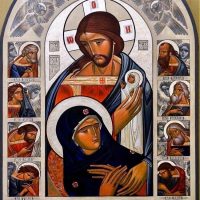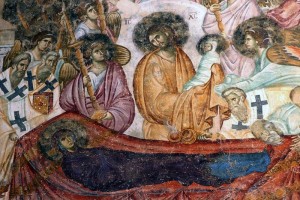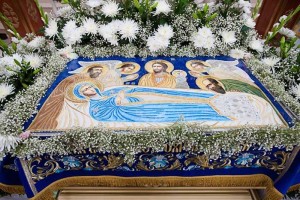Both Orthodox and Roman Catholics celebrate the mystery of Christ’s taking His Mother, body and soul, into Heaven. Yet both have quite different ways of approaching this Feast that reflects their differing perspectives on the Mother of Christ our God. Their liturgical focus is different one from another as are the very terms by which they name this Feast. Let’s take a closer look . . .
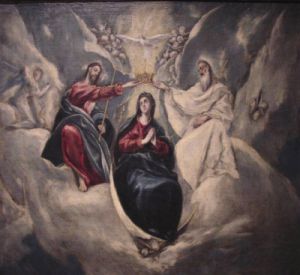 The Catholic West calls this Feast that of the “Assumption” or the assuming of the body and soul of the Virgin Mary into Heaven by God.
The Catholic West calls this Feast that of the “Assumption” or the assuming of the body and soul of the Virgin Mary into Heaven by God.
The corresponding Catholic image of this feast is the Mother of God being taken into heaven on a cloud and by angels. She is then crowned by the Holy Trinity or Her Son as the Chief Intercessor of the Church before the Divine Throne.
The Orthodox East, on the other hand, focuses on the actual “falling asleep” or death of the Mother of God (i.e. “Dormition”).
The focus of the Christian East is encapsulated in the Icon of the Dormition where the central attention is on the actual bier on which the reposed Mother of God lies in state, surrounded by the Apostles and Church Fathers, their successors.
Christ is positioned above the bier, holding in His Hands the image of His Mother Whom He is taking to Heaven, body and soul. Sometimes the icons of the Dormition portray the Mother of God already above, in heaven, with the Holy Trinity.
Some icons of the Dormition depict a fellow tradition names as “Athonius” who tried to attack the bier of the Mother of God and had his hands cut off by an Angel for his trouble. The hands are attached to the bier as the bewildered Athonius is about to repent of his action.
Other icons of the Dormition portray the Apostles being brought through the air by Angels from their far-off missions to attend the funeral of the Mother of God.
The Roman Catholic West tries not to even think of the “death of Mary.” Its doctrine of the Immaculate Conception, where the penal Original Sin (inherited guilt for Adam’s sin) does not “infect” the soul of Mary, owing to Her exalted future role as Mother of the Saviour.And since Adam’s sin is what brought death into the world, if Mary didn’t “contract it,” then how can she be said to have died i.e. an experience of punishment for a sin she had no share in?
In defining the doctrine of the Assumption, Pope Pius XII actually left open the question of whether Mary actually “died” or not. In a sense, he was constrained by the doctrine of the Immaculate Conception to do so.
This explains why only the taking of the Mother of God into heaven is celebrated by the Roman Church and why there is no mention or commemoration of her death.
For the Eastern Church, the Mother of God was truly conceived and born in all holiness and Grace and this is why Her Nativity is celebrated liturgically as well as her Conception in the womb of St Ann, since only the feast of a Saint may be celebrated.
For the Eastern Church, Original Sin has to do with the consequences of Adam’s sin that we have all contracted. We do not inherit the guilt of Adam’s personal sin, since only Adam is responsible for that. But as Adam’s offspring, we did inherit a human nature that was weakened by that disobedience to God and one that is subject to the laws of death.
So, for the Eastern Church, the consequences of Original Sin and Mary’s great holiness are not mutually exclusive theological realities.
Our liturgical heritage has always celebrated Her “funeral” before celebrating Her ascent to Heaven. The Dormition, so named also to indicate what a blessed repose in the Lord the Most Holy Mother of God had, is a commemoration of the death and resurrection in Christ of the Virgin Mary.
She experiences in the “now” what we are to experience too, our personal death and personal resurrection in Christ, body and soul.
The standing of Christ by the bier of His Mother is also an illustration of our Church’s view of the immediate state of the soul following our epose in the Lord.
We will be “tested” by the spirits of the air with whom we are in a struggle even now during our lives here.
The Mother of God, by tradition, asked Her Son not to be subjected to the terrors of this experience. The standing of Christ by His Mother’s bier is therefore an answer to the prayer of Her whose every request is granted by Christ!
She is most assuredly received into Heaven and crowned as the Mother of the Church, the Body of Christ. She is therefore the Mother of each and every one of us. This happened, in reality, at the moment when Christ Himself gave us His Mother to St John at the foot of the Cross.
To each of us, Christ Crucified says, “Behold, your Mother!”
Christ gave us everything He could and had in His power to give us. In the end, when He had nothing left to give us, He enriched us with the treasure of His own Mother and Her powerful, nurturing intercession and protection over our lives lived in Christ!
The Incarnation of God in Christ is not an illusion. Illusions don’t have mothers.
This is why the term, “Theotokos” or “Bearer of God” is a real touchstone of Orthodoxy. To call Her blessed who bore for us the Incarnate Word of God is to celebrate the entire dispensation of the Salvation of Christ!
A poet once wrote, “What honour should to that Woman be done, who had God for Father, Spouse and Son?”
This is also why we prepare for the celebration of the mystery of the repose and resurrection of the Mother of God with a special Lent of two weeks prior to the day.
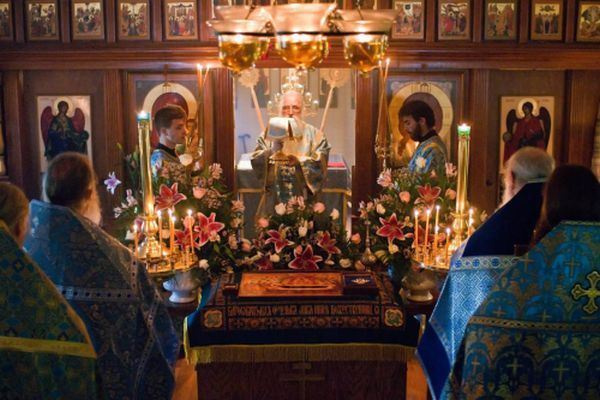
In Ukraine, there is the tradition of the Shroud or Winding Sheet (Plaschanitsya or Epitaphion) of the Dormition.
This is in imitation of the Shroud of our Lord venerated during the Paschal celebration.
The shroud of the Mother of God depicts Her in blessed repose and is placed on a similar holy spot in the middle of the Church on the feast day. The moving and tearful antiphons of the Funeral of the Mother of God are chanted slowly and sorrowfully.
“Where are you going today, Mother? Why do you leave us?” the Liturgy bids us cry on that day.
We become like the little children Christ would have us become in order to inherit the Kingdom of Heaven. And, like little children, we cry after our Mother Who has reposed and is leaving us.
But we know the Mother of God has not left us and will be in Heaven as our true Spiritual Mother to help form Christ Her Son in us. She will be with us every step of our way to make sure we don’t stumble too hard and to hold our hand as She leads us to a more perfect union with Her Son and the Holy Trinity.
The shroud of the Mother of God is often kept in a side chapel or separate building in many of our Churches, especially those named for the Holy Dormition.
There are also a number of miraculous Icons and Shrouds of the Dormition, the most famous one being that of the Kyivan Caves Lavra.
Like the Icon of Pochayiv, this Icon of the Dormition is held suspended above the Royal Doors of the main Iconostasis on ropes.
The icon is then lowered to the level of the faithful so that we may reverence it and be blessed by it.
The two main Shrines of the Mother of God in Ukraine are named for the Dormition, as a matter of fact, Pochayiv and the Kyivan Caves Lavra.
On that day, we truly are called to reach out our hands in sorrow as we see the Mother of God sleep a gentle, sweet sleep in the arms of Her Son and our Lord.
He nestled in Her arms as a Child. And now He takes His Mother into His own.
A saint had a vision once. He was in Heaven and was shown the places occupied by the different saints.
But when he came to the place occupied by the Mother of God, it was empty.
He was told that the Mother of God spends Her time on earth, doing good and interceding for people.
A tradition has it that there are four special places covered by the Protection of the Mother of God on earth. The City of Kyiv is among them.
The Feast of the Protection or the Mantle of the Mother of God is a fitting culmination of all Her Feasts.
The icon of the “Unmoveable Wall” or Oranta in Kyiv’s St Sophia Cathedral is an excellent example of such a “Pokrova” icon.
It is inscribed with the words from the Psalms: “God is within Her, She shall not be moved.”
So too with those of us who follow Christ’s directive to claim His Mother for our own. Like St John the Divine, we too are to take Her home with us, into our hearts and minds to nurture us into the full stature of Her Son, our Lord, God and Saviour, Jesus Christ.
You might also like:












